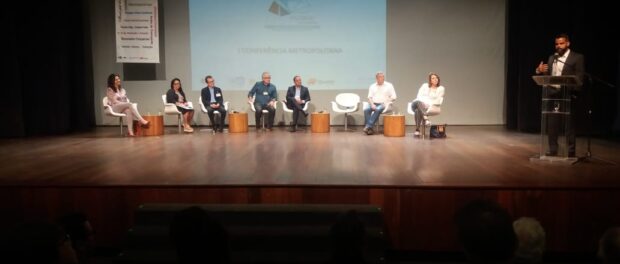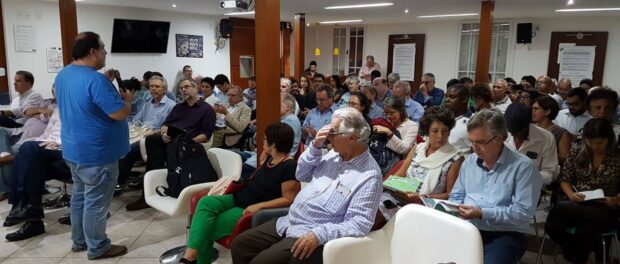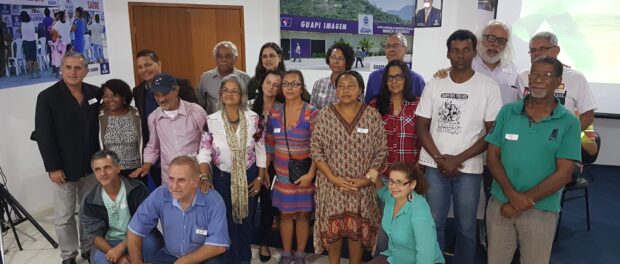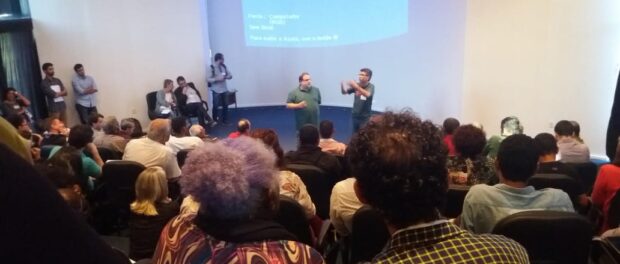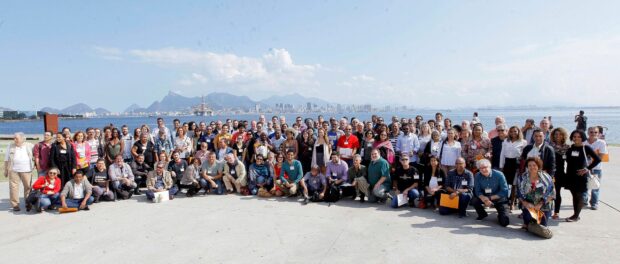
Metropolitan integration
As it was with Brazil’s 1988 Constitution that recognized cities as sites of planning and decision-making, granting them more autonomy, today there is a growing movement to recognize that there are also matters that go beyond city limits and demand collaboration across neighboring municipalities. Although this idea was reflected in the establishment of Brazilian metropolitan regions in 1973, with the goal of “integrating the organization, planning, and execution of public functions” of the cities involved, the shortage of administrative and political structures on a metropolitan level makes that mission hard. We do not vote, for example, for metropolitan representatives, and there are neither metropolitan departments nor metropolitan public policies. There is only the possibility of cooperation between different mayoral administrations.
Aiming to strengthen metropolitan management, the Metropolis Statute was approved in 2015 to establish general guidelines for cities to integrate the planning and execution of public functions, in addition to establishing instruments for intercity governance like the Integrated Urban Development Plan (PDUI). In order to institutionalize integrated management and coordinate the implementation of the PDUI, the Metropolitan Assembly of Government Integration was created in Rio de Janeiro in 2014. The governor, mayors, and the Executive Group of Metropolitan Management coordinate the Assembly’s actions in terms of elaborating diagnoses and proposals for planning and urban development.
Integrated management is particularly important for the 21 municipalities that make up the metropolitan region of Rio. It is impossible, for instance, to imagine the clean-up of the Guanabara Bay, which borders seven different municipalities, being accomplished through individual cities’ isolated initiatives. That’s because rain and the paths of rivers do not respect territorial boundaries in the case of floods, and because 2 million people leave their municipality every day to commute to the state’s capital city of Rio de Janeiro to access work, education, and services, traveling distances within a 70km radius from Rio’s center.
The Plan to “Model The Metropolis”
In 2015, it was through the Metropolitan Assembly and with financing from the World Bank that Rio’s state government hired a consortium formed by the companies Quanta Consultoria and Jaime Lerner Arquitetos Associados to elaborate “Modeling the Metropolis,” the Strategic Plan for the Integrated Urban Development of the Metropolitan Area of Rio de Janeiro. The plan’s name, with the verb “modeling”, reflects the plan’s orientation towards the future; it proposes possible scenarios and tools to orient decision-making, all in the service of the integrated development of the metropolis.
The process of elaborating the plan involved specialists representing six structural axes: economic expansion; natural and cultural heritage; mobility; housing and social structures; sanitation and the environment; and spatial reconfiguration. The process also incorporated input collected through dialogue with other government representatives as well as representatives from civil society, the private sector, universities, and various job sector-based networks. Over the three years of the plan’s development, there were more than 80 meetings (within regional and segment-based workshops), 94 presentations of the in-progress plan to organizations representing different sectors and civil society, 22 themed discussion groups based around the six axes, around 1,800 specialists heard, 10 pre-conferences, and one Metropolitan Conference, all of which amounted to over 5,000 people participating in these events. The goals of all these events included opening more direct participation channels, promoting more horizontal processes, and raising public awareness around the themes discussed, all in order to reduce inequalities, guarantee representation of all the municipalities in the plan, and contribute to a metropolitan identity.
This type of participation is called for in the Metropolis Statute itself, as Article 6 section V calls for the “democratic management of the city.” It follows the definition provided by its predecessor, the Cities Statute, which establishes tools for participation in democratic city management (article 43), in participatory budget management at the city level (article 44), and in the social participation forums of metropolitan and urban agglomerations’ administrative bodies (article 45), such as debates, public hearings, public consultations, and conferences about urban topics. Article 12 specifically determines that the PDUI must obey these mechanisms, not just in its elaboration but also its its implementation through monitoring and controlling its actions, through public hearings and debates with representatives from civil society and the populations of each city in the metropolis, and through the dissemination of the documents and information produced.
Participation has been a part of the diagnosis process and also of the prioritization of proposals to address them. One example of this participation was the adaptation of a proposal initially present in the plan about the use of the Guapi-Macacu and Guapiaçu rivers’ watershed basins. The plan initially called for the construction of a dam, an old proposal of the state government that residents are against because it would flood the properties of over 300 rural producers and could have consequences on the region’s climate dynamics. Due to civil society mobilization and a specific meeting organized with Cachoeiras de Macacu’s social movements, the dam was withdrawn from the plan.
1st Metropolitan Conference
Besides influencing the development of the plan, civil society will be able to monitor its implementation. During the 10 metropolitan pre-conferences, organized all over the metropolis’ territory, 36 out of the 131 actions outlined in the plan were identified as priorities while 150 delegates and 30 substitutes were elected to participate in the 1st Metropolitan Conference, which was held on Sunday, May 26, in the Popular Theater in Niterói. Of these delegates, 119 were civil society representatives. During the conference, each segment voted for representatives to compose the Plan Monitoring Forum. The forum mirrors the Metropolitan Agency’s Advisory Counsel, an organ for executing policies and metropolitan governance that was established in the proposed Complementary Law 10/2015, but which has not yet been put to a vote in the State Legislature of Rio de Janeiro (Alerj) due to conflicts of interest, like the perception that it will limit municipalities’ autonomy.
The forum aims to monitor and exercise social control of the government, so that it implements public policies according to the plan. At the conference, three representatives were elected from NGOs (Casa Fluminense, ISER, and FASE), three from career-based networks (OAB, SINTSAMA, and STI/PDAENIT), three from academia (UFF‘s Graduate Program in Sociology and Law, UFRJ‘s Graduate Program in Urbanism, and UFRRJ‘s Nature and City Research Group), and nine from social movements (including the ReciclAção project from Morro dos Prazeres; the Movimento Pró-Saneamento from the Baixada; the Federation of Maricá, Guapimirim and Japeri Residents Associations; the National Confederation of Residents Associations; the Transparency and Social Control Forum of Niterói; Pró-São Gonçalo; and Gomeia Galpão Criativo from the Baixada). Nine representatives from state and municipal executive governments, nine from the legislature, and nine from the business sector will also be selected.
Cris dos Prazeres, one of the founders of ReciclAção and one of the elected members of the forum, said: “I was very surprised by the conference. In addition to the serious political situation of the country and our state, we are in a moment of disbelief, discouragement. [So] seeing all those people together, from different parts of society! I thought it was amazing how much this occasion gathered different types of knowledge and views. On the day of the conference the buses were still paralyzed because of the truck drivers’ strike, [so] having almost 80% of the registered people present was wonderful. The organization was A+! I know how hard it is to bring in the public and keep them focused.” And she added: “I think spaces such as this are extremely constructive to the development of public policies. They are spaces of questioning, synergy, production of knowledge. People need to awaken a collective consciousness. The moment I produce knowledge that improves collective life, it improves mine too. And they make it so we are catalysts of information, so that this information can reach our territories, those that don’t have access to these spaces.”
Also at the conference, participants identified 12 of the 36 action proposals as the highest priorities, including: the regularization of urban infrastructure and and land associated with social investments in favelas and peripheries; the sustainable agroecological development of the region’s peri-urban areas; the establishment of dry weather flow networks in sanitary sewage systems; pollution control and the preservation of watershed basins; the implementation of separation of recyclables feeding into recycling coops; the fortification of other urban centers in the metropolis; the implementation of the metro’s Line 3 between São Gonçalo, Niterói, and Itaboraí; the use of railway structures and waterway transport in Guanabara Bay for the mass transportation of passengers; and the strengthening of the Metropolitan Agency and integrated planning.
Cris dos Prazeres rebutted criticism that, because it is a metropolitan plan, there are not many elements oriented specifically towards favelas: “The citizen of the favela is the citizen of the city, of the state. I look at it as a whole, I can’t make that distinction. If we keep the city divided, always looking at two cities inside one, we knock over the discourse on participation itself. We want to see public policies reaching this guy’s house and reaching the rest of the city around him too.” Regarding investment in favelas, specifically, she highlighted: “What we have in terms of service here doesn’t reach the poorer population, primarily because the data, the information that’s being produced, the census, leaves over half of the favela’s population invisible.”
Following the work done by civil society to prioritize the plan’s actions, the final version of the plan was delivered to public officials on Thursday, June 21.

